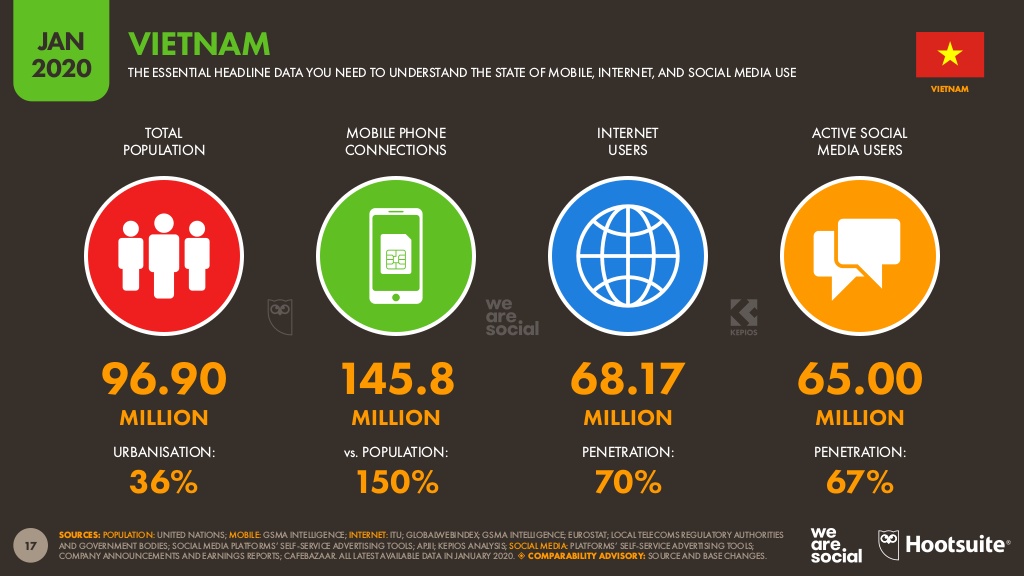Vietnam is a country of incredible beauty located in Southeast Asia. Described by Lonely Planet as “exotic and compelling,” this picturesque country has drastically improved in terms of social media and digital marketing landscape. The country’s only official language is Vietnamese (tiếng Việt).
The World Bank estimates that Vietnam’s US$200 billion economy is likely to rise to a trillion dollars by 2035. Over half of its population, compared with only 11% today, is anticipated to join the ranks of the global middle class with daily consumption of US$15 or more. About 30% of the population are purchasing goods and services over the internet in 2020, with each consumer spending an average of US$350 per year.
As one of Asia’s rapidly developing economies and youngest populations, Vietnam is a fascinating market. This young and dynamic country offers enormous commercial opportunities for both small and big brands, marketers and investors. This can be attributed to the digital trends in Vietnam that are emerging quickly in every notable sector.
This article will discuss Vietnam’s digital marketing environment, industry challenges and opportunities, successful campaigns, as well as the best possible ways on how to reach the Vietnamese audience.
Vietnam’s Digital Marketing Landscape
According to the 2020 Global Digital suite of reports from We Are Social and Hootsuite, Vietnam has a total population of about 96.90 million with a remarkable internet penetration rate of 70%. This accounts for 68.17 million Vietnamese that are online.
Among this number, 65 million of them are active social media users, which equates to a penetration rate of 67%. In April 2020, Vietnam rose into 7th place for the number of Facebook users worldwide, beating Thailand and Egypt.
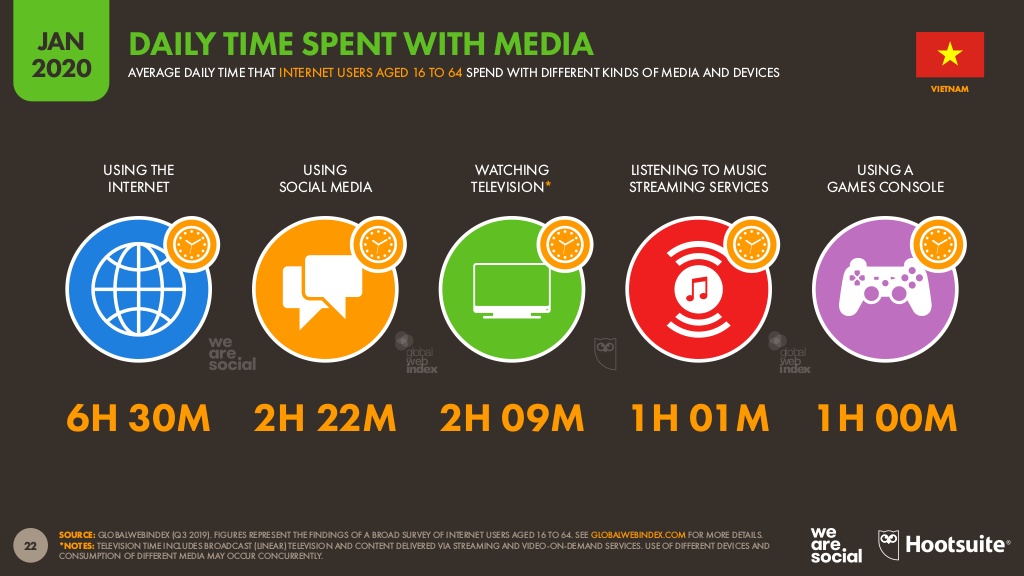
Source: https://datareportal.com/reports/digital-2020-vietnam?rq=DIGITAL%202020%3A%20VIETNAM
The average amount of time that Vietnamese spends online daily is nearly nine hours, including two hours and twenty-two minutes on social media.
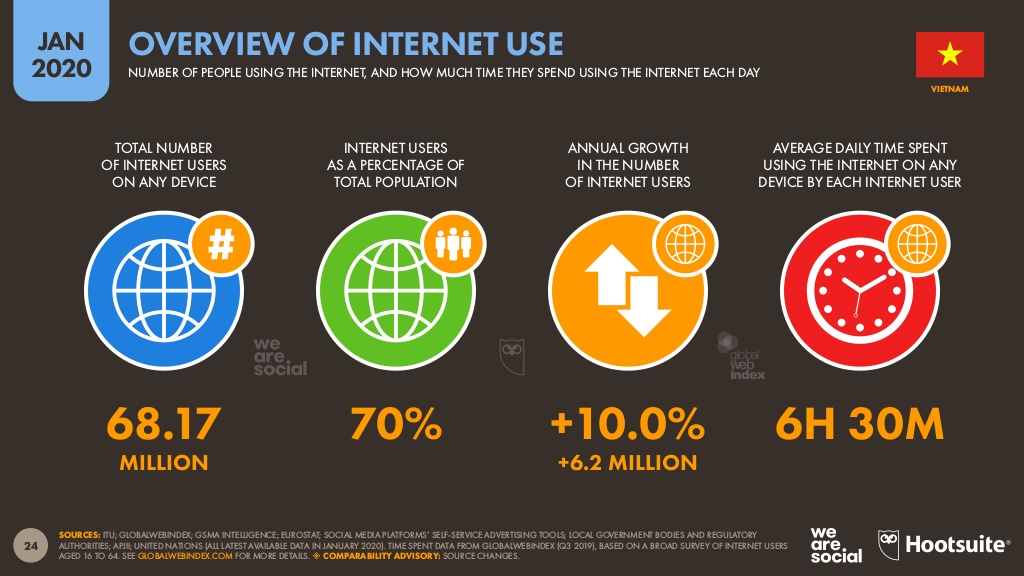
Source: https://datareportal.com/reports/digital-2020-vietnam?rq=DIGITAL%202020%3A%20VIETNAM
In addition, 70 % of Vietnamese access the Internet every day, and 95 % watch videos online, proving the significance of using videos as a form of digital marketing.
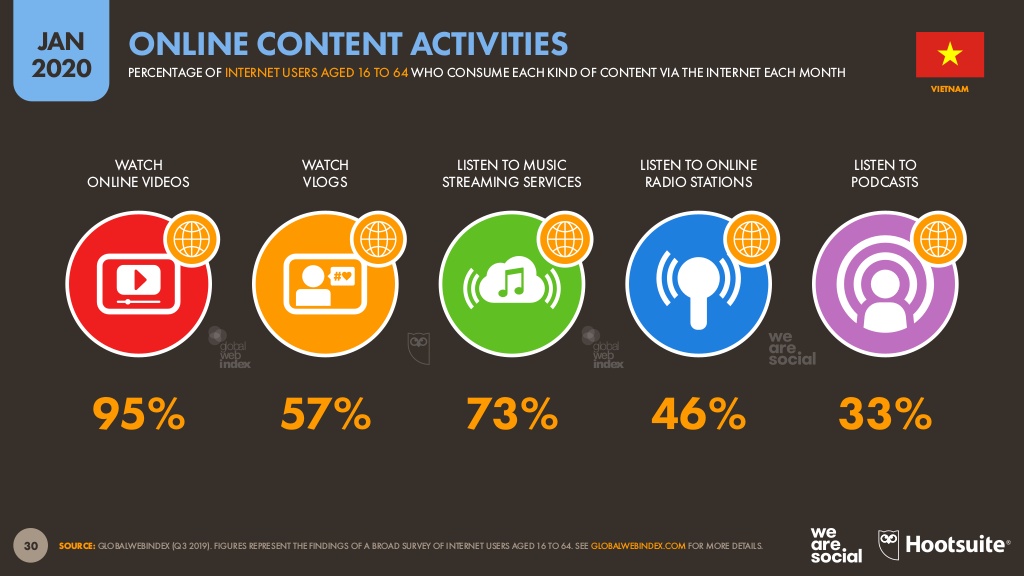
Source: https://datareportal.com/reports/digital-2020-vietnam?rq=DIGITAL%202020%3A%20VIETNAM
It comes as no surprise, therefore, that most Vietnamese get their news from the Internet, including social networking platforms such as Facebook, Twitter, and others.
According to the World Bank, these figures can be attributed to Vietnam’s high literacy rate in comparison to any country in a similar stage of development. Another reason is the widespread Internet access via 3G and Wi-Fi, as well the increasing number of 4G networks which are also reasonably priced. Lastly, Vietnamese are passionate readers of all kinds of news, both online and offline.
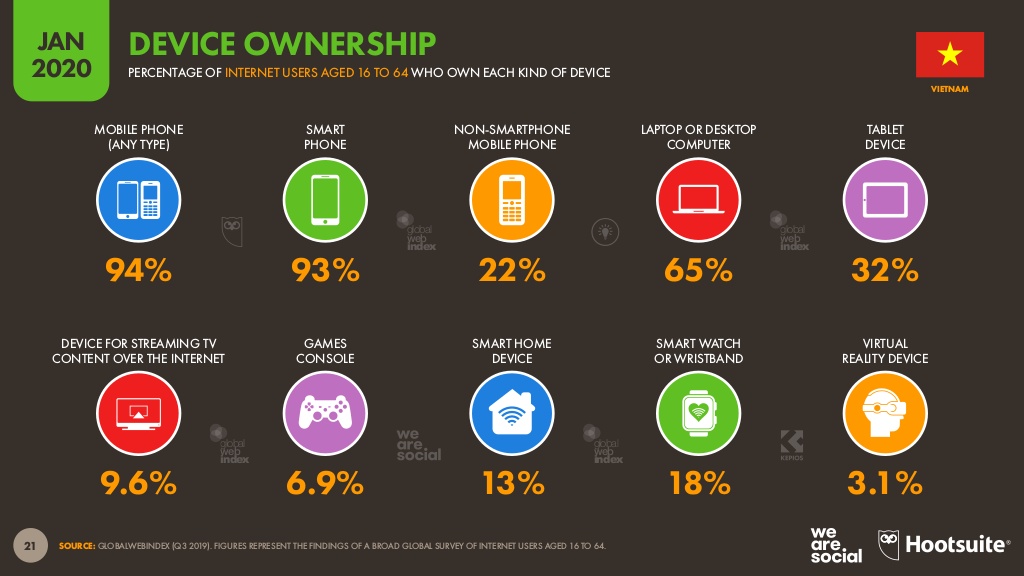
Source: https://datareportal.com/reports/digital-2020-vietnam?rq=DIGITAL%202020%3A%20VIETNAM
Furthermore, there’s a great desire to be online via mobile; recent research conducted by Reaching Vietnam found that Vietnamese often own several phones in order to take advantage of the best deals with competing providers. Regardless of this fact, smartphone penetration is still only around 93 %, leaving plenty of room for growth.
Biggest channels
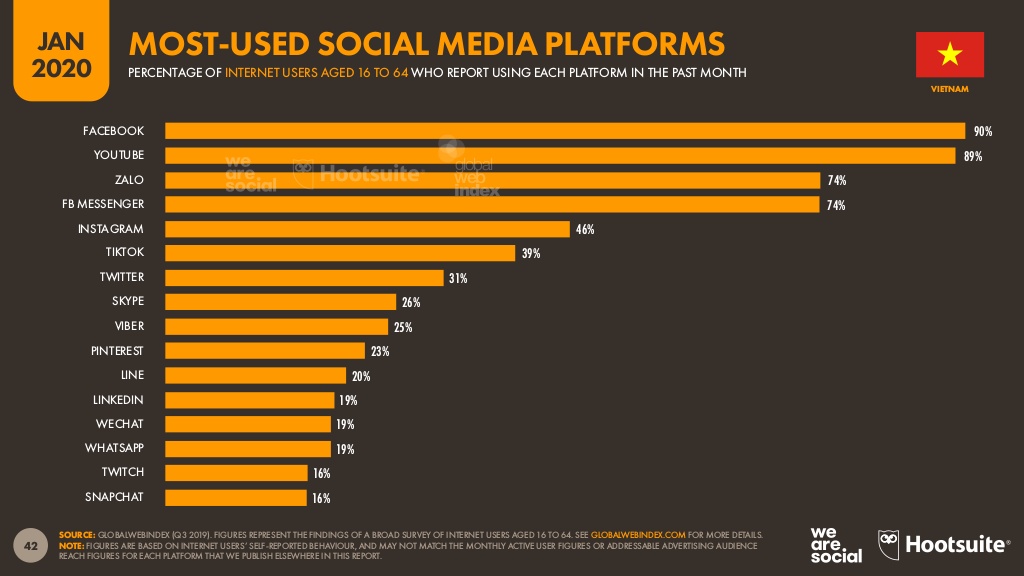
Source: https://datareportal.com/reports/digital-2020-vietnam?rq=DIGITAL%202020%3A%20VIETNAM
As mentioned earlier, 70 % of Vietnamese people have internet connection access and 95 % of the time, they watch online videos. In addition, Facebook is now the most popular social media platform with an average of 90 % of internet users who use the platform. YouTube follows after, with 89 % of internet users using it.
Most of the digital ad spend in the country goes to Digital Search ads at $118 million, making it one of the most prevalent digital marketing activities in Vietnam. However, based on the year-on-year digital ad spend, social media ads had a 17% increase from 2018 to 2019. The two most widely used online video platforms in the country are YouTube and Facebook. Although YouTube is more popular in terms of media, Facebook ads are used more often by brands when running advertisements.
It’s also interesting to see Zalo – Vietnam’s domestic social media platform– closely following behind YouTube in terms of the number of users. Its popularity can be attributed to how tailored it is to the Vietnamese user’s needs — it offers chat and voice call services, and also lets users search for administrative information.
Trends and Opportunities
Influencer Marketing
The use of social media has now become a norm across the globe. This has resulted in changes in consumer behavior, where customers look at fellow customers in order to have informed purchasing decisions. Instead of referring to companies as they have done in the past, consumers now look at each other and at their favorite personalities who have a huge following on YouTube, Instagram, Facebook, and other platforms. Due to these reasons, many digital marketers believe that influencer marketing will be the next big thing in advertising.
The rise of social media influencers opens many new opportunities. It offers a new channel for brands to communicate with consumers more directly, more organically, and at scale. By creating branded content with social media influencers, brands can amplify their message while appealing to their target market.

Source: https://blog.skyperry.com/top-6-successful-beauty-bloggers-vietnam.html
Big data and artificial intelligence
Big data and artificial intelligence play a vital role in marketing and advertising. New technologies recently invented can understand the deep insights of every single person and predict his/her behavior and actions by structuring collected data. Thus with insights about their audience, today’s marketers can design the most effective customer journey, which can engage customers with the best fitting brand experiences.
Companies can build a great database of their audience’s likes and dislikes, emotions, hobbies, interests, and even their relative connections on the Internet. These data will help precisely and accurately target a small segmented audience, and, at an even higher level, specific individuals. This strategy is also called personalized marketing.
A data-driven marketing strategy can help brands learn more about their audience as well as improve their tactics and future campaigns. In particular, it can help companies improve customer experience with the use of personalization and create more effective ads to reach the right audience.

Source: https://vietnamcentre.wordpress.com/2013/06/17/58-of-vietnamese-use-internet-nielsen/
Social Media Marketing
At present, there are 3.81 billion social media users across the globe, which equates to a 49 % market penetration. With that kind of figure, social media’s significance to society should be taken into consideration especially in the marketing world.
Social media has become part of almost everyone’s daily life. Thus, having insights and understanding of the changes and trends implemented in social networks are essential for businesses. The social media landscape changes a lot. Currently, the most popular social trends are video, automation, and influencers, but there will be more soon.
Most importantly, marketers should realize that dominating a single platform is no longer enough. Some leads on Facebook are not on YouTube, and those on YouTube are different from those reading website content. As such, the key to success is to tailor content across multiple, relevant platforms.
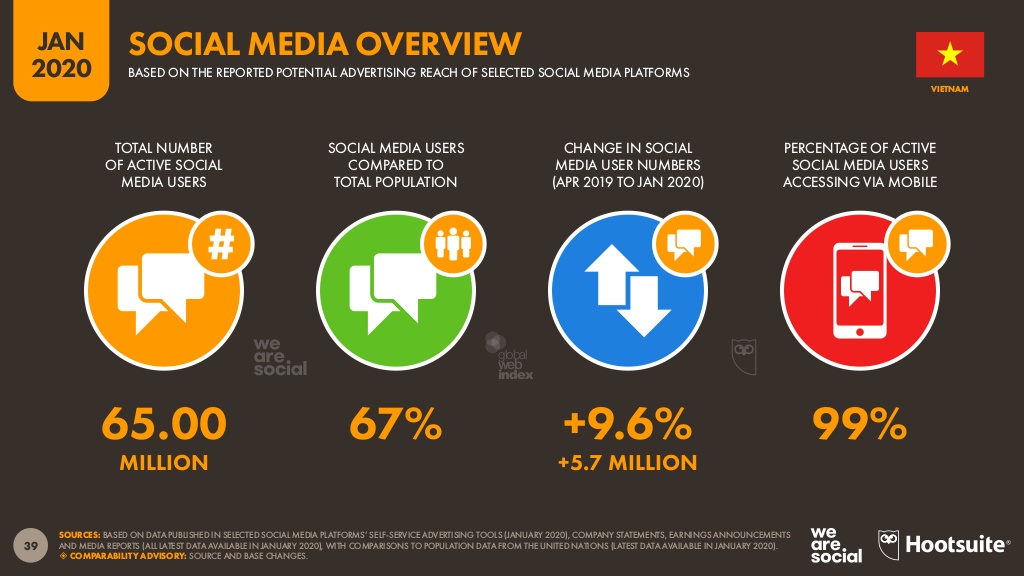
Source: https://datareportal.com/reports/digital-2020-vietnam?rq=DIGITAL%202020%3A%20VIETNAM
Video Marketing
Video consumption is expected to rise in the coming years. As more social networks enter into channeling video content, marketers are investing in video to engage their audience. However, producing videos with no clear objectives is futile. Marketers need to start spending more time on evaluating the best types of videos that work for their audience. Bite-sized videos may work on social media; however, there are also audiences that are more interested in watching longer videos. For instance, Instagram will invest more on IGTV to establish it as a new platform for longer videos. Even though the feature is still at an early stage, it has a great opportunity to beat the competition.
Video advertisements are also another trend to explore, either to increase awareness or drive conversions. According to Animoto, video ads are the primary way where customers can discover a brand or product before making a purchase. Furthermore, videos need to be optimized for mobile, while their call-to-action needs to be clear but not off-putting. Marketers need to focus on creating interesting videos that engage the viewers to keep on watching.
Successful campaigns
An example of a successful digital marketing campaign was “The Language of Hair” by Sunsilk. Sunsilk started the campaign by releasing a video advertisement about a geek who was attracted to a cute girl but didn’t understand the Hair FingerComb language that she used to express herself. The video was shared and promoted on YouTube and Zing TV (under Zalo). To reach their target audience on mobile platforms, Sunsilk posted the campaign on Zalo, the most popular social media chat app in Vietnam. Almost 67% of the target audience, which are young women, actively use Zalo to chat with friends and share photos daily. Sunsilk utilized video, media banners and online PR to lead their audience to the campaign fan page on Zalo.
The second part of the campaign involved “chibi,” which is Japanese slang referring to a short person or little child. Chibi drawings to create cute mini cartoon versions of girls have become a trend among Vietnamese women. In the campaign, Zalo users could submit their pictures to the Sunsilk page using Zalo chat, and Sunsilk’s Chibi Maker Tool created a personal chibi drawing based on the photo submitted and sent it back.
In addition, Sunsilk also launched a Chibi Maker Contest which challenged audience members to incorporate their knowledge of Hair FingerComb language into their chibi drawings in order to increase engagement. The best chibis were chosen, and Sunsilk released a Hair FingerComb Language Chibi Sticker Collection as a gift to Sunsilk users.
Summary
Digital technologies and online connectivity have the potential to be the key driving forces in the growth and transformation of the Vietnamese economy over the coming years. Thus, it is important for those wishing to enter the Vietnamese market to consider digital channels in their marketing campaigns. Several digital marketing strategies such as influencer marketing, big data and artificial intelligence, social media, and online videos are continuously rising in popularity within the country. Using these strategies can help brands achieve success.
We at Info Cubic Japan can help you learn more about online marketing in Vietnam.
Featured Photo by Florian Wehde on Unsplash

